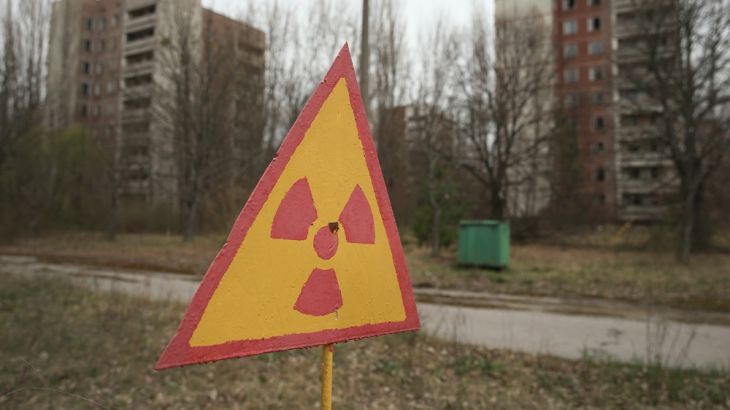As Russian forces seize Chernobyl plant, a look at its history
Russian forces took control of the Chernobyl power plant, the site of the world’s worst nuclear accident.

Russian forces have taken control of Chernobyl’s nuclear plant, the site of what has been described as the world’s worst nuclear accident.
Ukrainian President Volodymyr Zelenskyy on Thursday called Russia’s attack on Ukraine “a declaration of war on all of Europe”.
Keep reading
list of 4 itemsTurtles swimming to extinction in Malaysia as male hatchlings feel heat
Could shipping containers be the answer to Ghana’s housing crisis?
Thousands protest against over-tourism in Spain’s Canary Islands
“Our defenders are giving their lives so that the tragedy of 1986 will not be repeated,” Zelenskyy tweeted before the nuclear power plant was captured by Russian forces.
In 1986, explosions at the then-Soviet Chernobyl Nuclear Power Plant released large levels of radiation into the atmosphere, forcing thousands to flee their homes and sparking major fears over long-term health consequences and environmental destruction.
Here, we explain what happened, why, the reactions and the latest updates.
Where is Chernobyl?
- The Chernobyl plant is located some 100km from Ukraine’s capital, Kyiv, and about 20km from the border with Belarus.
- The nearest town is the now-abandoned Pripyat, which was purpose-built in 1970 to house workers from the plant and was home to between 40,000 and 50,000 people.
- At the time of the explosion, Ukraine was part of the Soviet Union.
![The Chernobyl Nuclear Power Plant was the site of one of the worst nuclear disasters in history [Vladimir Repik/Reuters]](/wp-content/uploads/2018/04/1fd607e7f84340e7ba51ed057f24bdbe_18.jpeg)
What happened there?
- In the early hours of April 26, 1986, one of the four nuclear reactors at the plant exploded.
- The explosions occurred during a test designed to check the Unit 4 reactor’s cooling functions on limited power. The power-regulating and safety systems were shut off before the test to avoid interruptions.
- The reactor was supposed to run at 25 percent capacity during the test but dipped to less than 1 percent, forcing workers to slowly increase the power levels.
- An unexpected power surge caused fuel pellets in the reactor to explode, triggering a larger explosion that blew the 1,000-tonne roof off of the reactor.
- A cloud of radioactive material was released into the atmosphere, while air mixing with carbon monoxide gas in the reactor ignited, causing a fire that burned for nine days.
Reaction
- Firefighters were initially deployed to pour water into the reactor, before being replaced by military helicopters that dropped more than 2,400 tonnes of lead and 1,800 tonnes of sand in an attempt to smother the fire and absorb the radiation.
- On April 27, a 30km circular area surrounding the plant was designated as the Chernobyl Nuclear Power Plant Zone of Alienation, also known as the Exclusion Zone.
- The 116,000 people living in the Exclusion Zone were evacuated and the area was put under military control. The zone was later expanded to cover a wider area and a further 230,000 people were relocated.
|
|
- Thousands of people were involved in attempts to contain the disaster, risking their health as a result. These people have come to be known as “liquidators“.
- A hastily-constructed “sarcophagus” dome made of steel and concrete was built over the reactor to stop the release of radiation into the atmosphere. Completed in November 1986, the dome fell into disrepair, prompting safety concerns and was replaced with a moveable metal structure in 2016.
- The Soviet Union was slow to acknowledge the severity of the incident until pressed to explain the unusually high levels of wind-transported radioactivity detected by monitoring stations in Sweden following the explosion. On April 28, a 20-second television announcement was made, acknowledging the incident.
- In 2000, the plant was officially decommissioned.
![A monument pays homage to the builders who constructed the first sarcophagus over the Unit 4 reactor, which was replaced in 2016 [Efrem Lukatsky/AP Photo]](/wp-content/uploads/2018/04/41e30af3e68f44c799595b86f5d94d6b_18.jpeg)
How many people died?
- At least two people were killed as a result of the initial explosions.
- The extent of the health impact of the disaster remains highly controversial as, in some cases, it is difficult to isolate radiation as the singular cause of death or disease.
- According to the World Health Organization, about five million people are currently living in areas of Belarus, Russia and Ukraine with high levels of radiation.
- More than 130 people who were either on-site at the time of the explosion or involved in the initial clean-up operation were confirmed as suffering from Acute Radiation Syndrome (ARS).
- Of these 134 people, 28 died within a few weeks of the incident.
- There has been a large increase in thyroid cancer among people who were children living in the most contaminated areas at the time of the explosion, with some 5,000 cases detected across Russia, Ukraine and Belarus. This is due to the consumption of milk from cows that grazed on pastures contaminated with radioactive iodine.
What are the latest developments?
- Currently, Chernobyl is under the control of Russian forces and, on Friday, Ukraine’s nuclear agency said they were recording increased radiation levels from the site.
- Experts said the changes were due to the military equipment in the area affecting the radioactive dust in the area.
- According to Ukrainian officials, Russian forces were holding staff hostage.